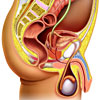Introduction to radical prostatectomy
Radical prostatectomy is a surgical procedure that involves the removal of the prostate gland and the attached seminal vesicles. Lymph nodes near the prostate can be removed during the same procedure. This is one option for men with localised prostate cancer. Advantages of this procedure include better pathological indication of cancer subtype, easier detection of recurrence and easier follow-up and radiation can be given following surgery with minimal side effects. Patients in good health, who have a long life expectancy and with prostate cancer confined to the prostate gland are candidates for radical prostatectomy.
The prostate
The prostate gland is a structure which lies below the bladder and encompasses the urethra (urine tube). It functions in secreting fluid that contributes to the make-up of semen. Cancer of the prostate can occur when the cells of the prostate begin to change and display cancerous or abnormal properties. One treatment for localised prostate cancer (one that has not spread to other parts of the body – i.e. metastasised) is radical prostatectomy.
Removing the prostate
Radical prostatectomy involves the complete removal of the prostate gland and structures called seminal vesicles (which are attached to the prostate and also contribute to semen production). Radical prostatectomy can be done by making an incision in the abdomen (radical retropubic prostatectomy), the perineum (radical perineal prostatectomy) or laparoscopically. In addition to removing the prostate gland, local lymph nodes may be removed (as this is one of the major ways that cancer spreads) – this is called a pelvic lymph node dissection. Radical prostatectomy is usually considered to be an optimal treatment for men usually under 70, with localised prostate cancer (confined to the prostate gland) and with no other major medical problems.
This method is indicated with the hope of ridding the cancer entirely whilst it is still confined to the prostate. There are some potential complications involved with radical prostatectomy. These include surgical risks, e.g. bleeding, infection, deep vein thrombosis, rectal injury, catheter problems. Longer term complications may include altered bowel function, incontinence and impotence. However, as technology advances and surgery improves, the risks of these complications has reduced significantly over time.
More information
 |
For more information on prostate cancer, including diagnoses, types of treatments, and some useful tools, videos and animations, see Prostate Cancer. |
References
All content and media on the HealthEngine Blog is created and published online for informational purposes only. It is not intended to be a substitute for professional medical advice and should not be relied on as health or personal advice. Always seek the guidance of your doctor or other qualified health professional with any questions you may have regarding your health or a medical condition. Never disregard the advice of a medical professional, or delay in seeking it because of something you have read on this Website. If you think you may have a medical emergency, call your doctor, go to the nearest hospital emergency department, or call the emergency services immediately.








